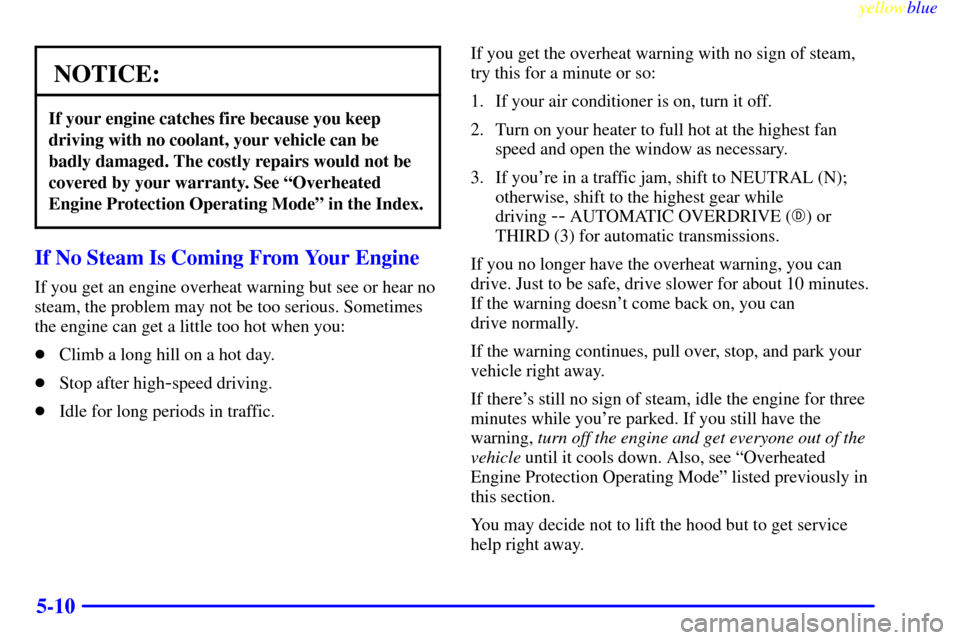Page 147 of 376
yellowblue
2-95
Press the GAGE button again to display the oil
temperature, such as:
�OIL TEMP 234 �F or
�OIL TEMP 112 �C
Press the GAGE button again to display the coolant
temperature, such as:
�COOLANT TEMP 123 �F or
�COOLANT TEMP 51 �C
Press the GAGE button again to display the transmission
fluid temperature (automatic transmission only),
such as:
�TRANS FLUID 123 �F or
�TRANS FLUID 51 �C
Press the GAGE button again to display the battery
voltage, such as:
�BATTERY VOLTS 13.5
Press the GAGE button again to display the tire pressure
for the front tires (left and right), such as:
�FRONT L34 R33 PSI or
�FRONT L234 R228 kPaPress the GAGE button again to display the tire pressure
for the rear tires (left and right), such as:
�REAR L34 R33 PSI or
�REAR L234 R228 kPa
Note that tire pressure is not available until the vehicle
has reached a speed of 15 mph (24 km/h) or more.
3 TRIP
The TRIP button allows you to scroll through the
functions listed below when you press it.
Page 152 of 376

yellowblue
2-100
Approach Lights
Press the OPTIONS button until APPROACH LIGHTS
appears on the display, then use the RESET button to
page through the following choices:
�APPROACH LIGHTS ON
�APPROACH LIGHTS OFF
If you choose APPROACH LIGHTS ON, the fog lamps,
front turn signal, rear back
-up and courtesy lamps will
come on for 30 seconds when you press UNLOCK on
the key fob transmitter. This will occur only when it is
dark outside.
APPROACH LIGHTS OFF turns off this option.
See ªRemote Function Actuation (RFA) Systemº in the
Index for more information.
Auto Lock
Press the OPTIONS button until AUTO LOCK appears
on the display, then use the RESET button to page
through the following choices:
�AUTO LOCK ON
�AUTO LOCK OFFIf you choose AUTO LOCK ON, both doors will
automatically lock when the vehicle exceeds 10 mph (16
km/h) in a manual transmission. In a vehicle with an
automatic transmission, both doors will automatically
lock when you move the shifter out of PARK (P).
Choose AUTO LOCK OFF to turn this option off.
Auto Unlock
The AUTO UNLOCK will be available only if AUTO
LOCK is set to ON.
Press the OPTIONS button until AUTO UNLOCK
appears on the display, then use the RESET button to
page through the following choices:
�AUTO UNLOCK DRIVER
�AUTO UNLOCK BOTH
�AUTO UNLOCK OFF
If you choose AUTO UNLOCK DRIVER, the driver's
door will automatically unlock when you turn the
vehicle off and pull the key out of the ignition.
Choose AUTO UNLOCK BOTH, and both doors will
automatically unlock when you turn the vehicle off and
pull the key out of the ignition.
AUTO UNLOCK OFF turns off this option.
Page 160 of 376

yellowblue
2-108
HIGH TRANS TEMP (Automatic Transmission
Only): You will hear four chimes when this message
is displayed. To acknowledge this warning, press the
RESET button. After you press the RESET button,
the message will be displayed every 10 minutes until the
condition changes. If you do not press RESET,
the message remains on the display until the
condition changes.
If the transmission fluid temperature rises above
270�F (132�C) or rises rapidly, this message is
displayed. The transmission may shift gears or apply the
torque converter clutch to reduce the fluid temperature.
Driving aggressively or driving on long hills can cause
the transmission fluid temperature to be higher than
normal. If this message appears, you may continue to
drive at a slower speed. You should also monitor the
transmission fluid temperature and allow it to cool to at
least 230�F (110�C). The transmission fluid temperature
can be monitored with the GAGES button on the DIC.
See ªAutomatic Transmission Fluidº in the Index.
You should also check the engine coolant temperature.
If it is also hot, see ªEngine Overheatingº in the Index.If the HIGH TRANS TEMP message is displayed
during normal vehicle operation on flat roads,
your vehicle may need service. See your dealer for
an inspection.
SERVICE ACTIVE HANDLING: If the SERVICE
ACTIVE HNDLG message is displayed, there is a
problem with your Active Handling System and your
vehicle needs service. The instrument cluster light will
also be on and a chime will sound. When this message is
displayed, the system is not working. Adjust your
driving accordingly.
ACTIVE HANDLING: Your vehicle is equipped with
an optional computer controlled system to assist the
driver in controlling the vehicle in difficult driving
conditions. You may feel or hear the system working
and see the ACTIVE HANDLING message displayed in
the DIC. This is normal when the system is operating.
Page 164 of 376
yellowblue
2-112
Other Messages
Here are more messages that you can receive on your
Driver Information Center (DIC). To acknowledge a
message and read another message that may have come
on at the same time, press the RESET button.
�BRAKE BEFORE SHIFT (Automatic
Transmissions Only)
�CHANGE OIL NOW (See ªEngine Oil Lifeº in
the Index.)
�CHANGE OIL SOON (See ªEngine Oil Lifeº in
the Index.)
�CRUISE DISENGAGED (See ªCruise Controlº in
the Index.)
�CRUISE SET __ MPH (__ km/h) (See ªCruise
Controlº in the Index.)
�DOOR AJAR�ENGINE PROTECTION REDUCE ENGINE RPM
�TRUNK AJAR (Convertible/Hardtop)
�HATCH AJAR (Coupe)
�HIGH VOLTAGE
�LOW BRAKE FLUID (See ªBrake Fluidº in
the Index.)
�LOW FUEL (See ªFuel Gageº in the Index.)
�LOW VOLTAGE
�LOW WASHER FLUID
�RESERVE FUEL
�UPSHIFT NOW
Page 238 of 376

yellowblue
5-10
NOTICE:
If your engine catches fire because you keep
driving with no coolant, your vehicle can be
badly damaged. The costly repairs would not be
covered by your warranty. See ªOverheated
Engine Protection Operating Modeº in the Index.
If No Steam Is Coming From Your Engine
If you get an engine overheat warning but see or hear no
steam, the problem may not be too serious. Sometimes
the engine can get a little too hot when you:
�Climb a long hill on a hot day.
�Stop after high
-speed driving.
�Idle for long periods in traffic.If you get the overheat warning with no sign of steam,
try this for a minute or so:
1. If your air conditioner is on, turn it off.
2. Turn on your heater to full hot at the highest fan
speed and open the window as necessary.
3. If you're in a traffic jam, shift to NEUTRAL (N);
otherwise, shift to the highest gear while
driving
-- AUTOMATIC OVERDRIVE (�) or
THIRD (3) for automatic transmissions.
If you no longer have the overheat warning, you can
drive. Just to be safe, drive slower for about 10 minutes.
If the warning doesn't come back on, you can
drive normally.
If the warning continues, pull over, stop, and park your
vehicle right away.
If there's still no sign of steam, idle the engine for three
minutes while you're parked. If you still have the
warning, turn off the engine and get everyone out of the
vehicle until it cools down. Also, see ªOverheated
Engine Protection Operating Modeº listed previously in
this section.
You may decide not to lift the hood but to get service
help right away.
Page 251 of 376

6-
yellowblue
6-1
Section 6 Service and Appearance Care
Here you will find information about the care of your vehicle. This section begins with service and fuel information,
and then it shows how to check important fluid and lubricant levels. There is also technical information about your
vehicle, and a part devoted to its appearance care.
6
-2 Service
6
-3 Fuel
6
-6 Filling Your Tank
6
-9 Checking Things Under the Hood
6
-12 Engine Oil
6
-16 Engine Air Cleaner/Filter
6
-18 Automatic Transmission Fluid
6
-19 Manual Transmission Fluid
6
-20 Hydraulic Clutch
6
-21 Rear Axle
6
-22 Surge Tank Pressure Cap
6
-23 Engine Coolant
6
-26 Power Steering Fluid
6
-27 Windshield Washer Fluid
6
-29 Brakes
6
-32 Battery
6
-33 Bulb Replacement
6
-38 Windshield Wiper Blade Replacement
6
-41 Tires6
-52 Lifting Your Corvette
6-56 Appearance Care
6
-56 Cleaning the Inside of Your Vehicle
6
-59 Cleaning a Removable Roof Panel
6
-60 Cleaning the Outside of Your Vehicle
6
-61 Cleaning Your Convertible Top
6
-62 Cleaning Aluminum Wheels
6
-62 Cleaning Tires
6
-62 Finish Damage
6
-63 Underbody Maintenance
6
-64 GM Vehicle Care/Appearance Materials
6
-65 Vehicle Identification Number (VIN)
6
-65 Service Parts Identification Label
6
-66 Electrical System
6
-74 Replacement Bulbs
6
-74 Capacities and Specifications
6
-76 Air Conditioning Refrigerants
6
-76 Normal Maintenance Replacement Parts
Page 268 of 376

yellowblue
6-18
2. Pull the assembly out.
3. Replace the filter.
4. Push the assembly back into place.
5. Fasten the clips.
Automatic Transmission Fluid
How to Check
Because this operation is difficult, you may choose to
have this done at your dealer service department. It is
not necessary to check the transmission fluid level. A
transmission fluid leak is the only reason for fluid loss.
If a leak occurs, take the vehicle to your dealer service
department and have it repaired as soon as possible.
There is a special procedure for checking and changing
the transmission fluid. Contact your dealer for additional
information or the procedure can be found in a Corvette
Service Manual. To purchase a service manual, see
ªService and Owner Publicationsº in the Index.
NOTICE:
We recommend that only fluid labeled
DEXRON�-III be used, because fluid with
that label is made specially for your automatic
transmission. Damage caused by fluid other than
DEXRON
�-III is not covered by your new
vehicle warranty.
Page 302 of 376

yellowblue
6-52 Tire Chains
NOTICE:
Don't use tire chains. They can damage your
vehicle because there's not enough clearance.
Use another type of traction device only if its
manufacturer recommends it for use on your
vehicle and tire size combination and road
conditions. Follow that manufacturer's
instructions. To help avoid damage to your
vehicle, drive slowly, readjust or remove the
device if it's contacting your vehicle, and don't
spin your wheels.
If you do find traction devices that will fit, install
them on the rear tires.
Lifting Your Corvette
CAUTION:
Lifting a vehicle can cause an injury. The vehicle
can slip off the jack and roll over you or other
people. You and they could be badly injured.
Find a level place to lift your vehicle. To help
prevent the vehicle from moving:
1. Set the parking brake firmly.
2. Put an automatic transmission shift
lever in PARK (P), or shift a manual
transmission to FIRST (1) or
REVERSE (R).
3. Turn off the engine.
To be even more certain the vehicle won't move,
you can put blocks in front of and behind
the wheels.